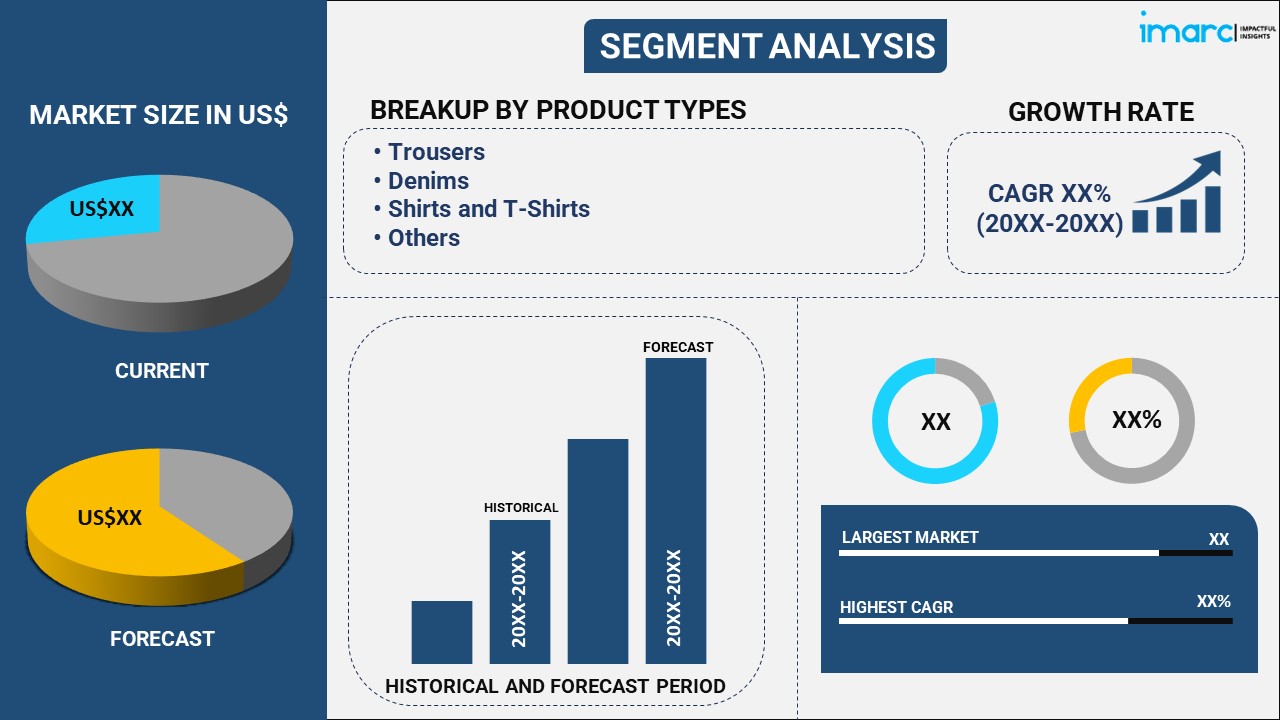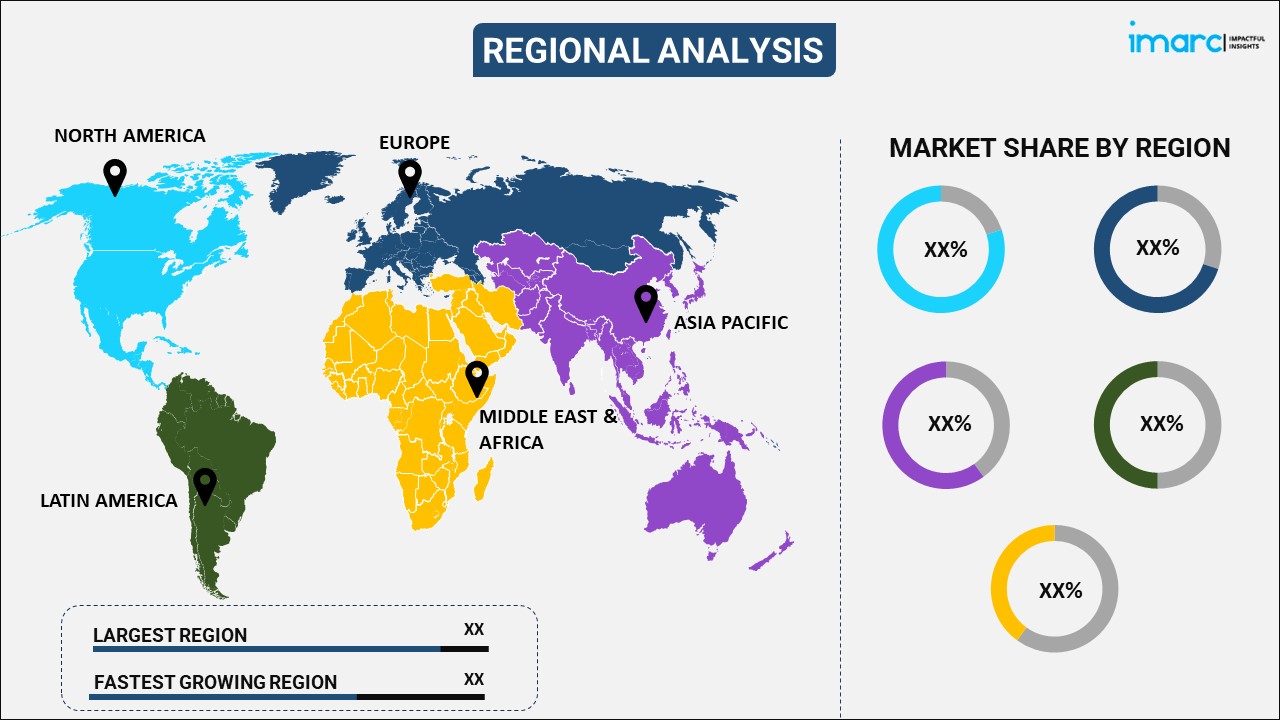
Report Attribute Key Statistics Base Year Forecast Years Historical Years Market Size in 2023 Market Forecast in 2032The global menswear market size reached US$ 593.5 Billion in 2023. Looking forward, IMARC Group expects the market to reach US$ 948.4 Billion by 2032, exhibiting a growth rate (CAGR) of 5.2% during 2024-2032. The rising fashion-consciousness among the male population, expanding e-commerce channel, and the introduction of sustainable clothing produced from natural materials to prevent skin allergies, are some of the key factors propelling the market growth.

Growing Inclination for Online Shopping Among Men
The increasing internet penetration and the expanding e-commerce sector are primarily driving the growth of the market. Furthermore, the inflating disposable incomes of consumers and the rising focus on physical appearances among men are also bolstering the menswear market demand for high-end brands and rare products. Moreover, with the increasing number of online users, there has been a steady rise in online transactions and the average amount of money spent online. For instance, in 2023, Amazon's total consolidated net sales revenue amounted to US$ 575 Billion, US$ 131 Billion of which were generated through international revenue channels. North America was the biggest operations segment, accumulating nearly US$ 353 Billion in net sales during the year. In addition to this, many luxury brands are forming partnerships with technology companies to enhance people's shopping experiences. For instance, in February 2022, LMVH Japan and SoftBank Corp. signed a partnership agreement. This agreement enhanced the online sales of LMVH with the help of the expertise of SoftBank Corp. in digitalization.
Increasing Demand for Ecological Clothing
The growing environmental consciousness among consumers is augmenting the need for sustainable clothing materials, which is positively impacting the menswear market outlook. In response to this, several leading brands are introducing ecological clothing made from organic materials as opposed to synthetic fabrics that can cause skin allergies. Based on data from the sustainable fashion industry, the market is projected to develop at a compound annual growth rate of 9.1%, reaching US$ 9.81 Billion in 2025 and US$ 15.17 Billion in 2030. This growth is attributed to the increasing awareness of ethical fashion. Additionally, according to the McKinsey Report 2020 sustainable fashion statistics, 60% of users are starting to make an effort to recycle and reuse items rather than buying them impulsively. In response to this, various key market players are utilizing fabrics made from organic cotton, bamboo, and recycled polyester to offer sustainable options to customers without compromising on style or quality. Such changes in product manufacturing are anticipated to propel the menswear market share in the coming years.
Increasing Product Offerings
Various key market players are increasingly investing in the development of more innovative and sustainable fashion products at affordable price ranges. For instance, Y Chroma, launched in 2023, showcased age-defying designs in February 2024, New York Fashion Week menswear. The new fashion brand is on a mission to target the often-ignored middle-aged bracket. Besides this, various menswear fashion brands are also raising funds to expand their operations and increase their customer base, which is projected to propel the menswear market revenue in the coming years. For instance, in December 2023, Men's direct-to-consumer (D2C) fashion brand Snitch raised INR 110 Cr (US$ 13.19 Million) in a Series A funding round co-led by SWC Global and IvyCap Ventures. The company will use the fresh capital to scale up its talent and technology, as well as to build an offline retail strategy. Snitch claims to have achieved a turnover of more than INR 100 Cr in FY23. Moreover, various brands are offering plus-size apparel to cater to diverse body types and ensure that individuals of all shapes and sizes can find well-fitting and stylish garments. For example, in April 223, fashion-focused multi-brand retail chain Shoppers Stop announced the launch of the company's plus-sized private label under the 'U R You' brand.
IMARC Group provides an analysis of the key trends in each segment of the global menswear market report, along with forecasts at the global, regional, and country levels from 2024-2032. Our report has categorized the market based on product type, season, and distribution channel.
Breakup by Product Type:

Shirts and t-shirts hold the largest market share
The report has provided a detailed breakup and analysis of the menswear market based on the product type. This includes trousers, denims, shirts and T-shirts, ethnic wear, and others. According to the menswear market report, shirts and T-shirts hold the largest market share.
T-shirts and shirts are one of the most comfortable clothing apparel among menswear. The increasing number of male students in colleges and universities and the rising percentage of working professionals requiring a variety of shirts and T-shirts for daily wear are contributing to the growth of this segment. Various well-established brands are increasingly launching a new range of T-shirts and shirts to cater to the augmenting demand. For instance, in April 2024, Aeroswag launched a new T-shirt line. The new product line includes nearly 2,000 aircraft designs and includes military, GA, business aviation, helicopters, airliners, vintage, and even UAVs.
Breakup by Season:
All-season wear currently exhibits clear dominance in the market
The report has provided a detailed breakup and analysis of the menswear market based on the season. This includes summer wear, winter wear, and all-season wear. According to the report, all-season wear currently exhibits clear dominance in the market.
All-season wear menswear refers to clothing designed to be versatile and suitable for wear throughout the year, regardless of weather conditions. They are cost-effective, since they reduce the need for seasonal wardrobe updates, practicality in adapting to varying temperatures and climates, versatility in styling options for different occasions, and convenience for travelers or those with limited storage space. The growing demand for all-season menswear is anticipated to propel the menswear market recent price in the years to come.
Breakup by Distribution Channel:
Exclusive stores account for the majority of the total market share
The report has provided a detailed breakup and analysis of the menswear market based on the distribution channel. This includes supermarkets and hypermarkets, exclusive stores, multi-brand retail outlets, online stores, and others. According to the report, exclusive stores account for the majority of the total market share.
Men's wear exclusive stores are retail establishments that specialize solely in clothing, accessories, and apparel tailored specifically for male customers, offering a curated selection of fashion items and personalized shopping experiences. These stores offer clothing and accessories tailored to individual tastes and preferences, and the opportunity to access unique and limited-edition designs. As per the menswear market overview, various market players are expanding via exclusive stores and increasing their customer footfall. For instance, D2C menswear brand DaMENSCH is aiming to open 100 stores by the end of 2024. The brand said it is catering to slow fashion demand and encouraging consumers to stock their wardrobes with clothes that can be used multiple times, thereby advocating a sense of sustainable clothing.
Breakup by Region:

North America currently dominates the global market
The report has also provided a comprehensive analysis of all the major regional markets, which include North America (the United States and Canada); Asia Pacific (China, Japan, India, South Korea, Australia, Indonesia, and others); Europe (Germany, France, the United Kingdom, Italy, Spain, Russia, and others); Latin America (Brazil, Mexico, and others); and the Middle East and Africa. According to the report, North America represents the largest regional market for Menswear.
The growth in the region can be attributed to the presence of a younger population and inflating the spending capacities of consumers. For instance, in 2022, approximately 21.64 million young people between the ages of 15 to 19 years old lived in the United States. This was a slight increase from the previous year, when 21.57 million young people aged 15 to 19 lived in the U.S. Moreover, menswear market statistics by IMARC indicate that, the presence of well-established menswear brands in the region is increasingly driving their product offerings to expand the consumer base, which is creating a positive outlook for the overall market. For instance, in October 2023, U.S. Skims officially announced the launch of Skims Mens with an All-Star campaign featuring football icon Neymar Jr, 2022 NFL Defensive Player of the Year Nick Bosa, and NBA All-Star Shai Gilgeous-Alexander. The collection features technically constructed briefs, soft boxers, and comfortable tanks and tees.
The report has provided a comprehensive analysis of the competitive landscape in the market. Detailed profiles of all major companies have also been provided. Some of the key players in the market include:
(Please note that this is only a partial list of the key players, and the complete list is provided in the report.)
The global menswear market was valued at US$ 593.5 Billion in 2023.
2. What is the expected growth rate of the global menswear market during 2024-2032?We expect the global menswear market to exhibit a CAGR of 5.2% during 2024-2032.
3. What are the key factors driving the global menswear market?The rising fashion-consciousness among the male population and introduction of sustainable clothing produced from natural materials to prevent skin allergies are some of the menswear market recent opportunities driving the growth of the market.
4. What has been the impact of COVID-19 on the global menswear market?The sudden outbreak of the COVID-19 pandemic has led to the changing consumer inclination from conventional brick-and-mortar distribution channels towards online retail platforms for the purchase of menswear.
5. What is the breakup of the global menswear market based on the product type?Based on the product type, the global menswear market can be categorized into trousers, denims, shirts and t-shirts, ethnic wear, and others. The menswear market forecast by IMARC, indicated that the shirts and t-shirts hold the largest market share.
6. What is the breakup of the global menswear market based on the season?Based on the season, the global menswear market has been segmented into summer wear, winter wear, and all-season wear. Among these, all-season wear currently exhibits clear dominance in the market.
7. What is the breakup of the global menswear market based on the distribution channel?Based on the distribution channel, the global menswear market can be bifurcated into supermarkets and hypermarkets, exclusive stores, multi-brand retail outlets, online stores, and others. Currently, exclusive stores account for the majority of the total market share.
8. What are the key regions in the global menswear market?On a regional level, the market has been classified into North America, Asia Pacific, Europe, Latin America, and Middle East and Africa, where North America currently dominates the global market.
9. Who are the key players/companies in the global menswear market?Some of the major players in the global menswear market include Adidas AG, Burberry Group Plc, Gap Inc, Giorgio Armani S.p.A, H&M Hennes & Mauritz AB, Kering S.A., Levi Strauss & Co., Nike Inc., Prada S.p.A., PVH Corp., Ralph Lauren Corporation, Zara S.A. (Industria de Diseño Textil, S.A.), etc.